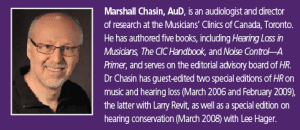Back to Basics | October 2014 Hearing Review
By Marshall Chasin, AuD

Marshall: “Hello. I am calling on behalf of Mr Smith [not his real name; it’s actually Mr Szchezewski but I can’t spell Szchezewski]. His claim for noise exposure and hearing loss was denied because he has an asymmetrical hearing loss.”
WCB agent: “What does asymmetrical mean? Hold on, I will transfer you to our linguistics and grammar department.”
Marshall: “Wait! I just meant that the worker’s hearing loss is different in both ears.”
WCB agent: “Oh that. Let me check our policy book…It says, ‘If there is an audiometric asymmetry, then the etiology is not noise-induced hearing loss.’ That seems clear. Thank you for calling and have a nice day.”
…and she hangs up.
Other than the agent on the phone being rather obtuse, it is a widespread belief that industrial noise exposure should be affecting both ears similarly, resulting in an audiogram that is essentially symmetrical. But why is that?
Most industrial sources of noise exposure have much of their energy in the lower frequency region and most industrial environments tend to also be highly reverberant. There are usually hard concrete floors, hard reflective machinery, and, in general, minimal acoustic treatment. Sounds that emanate from a machine to a worker’s left side bounce around the room and reach the worker’s right side with minimal loss of energy—the walls, ceiling, and machinery do not absorb much of the reflected energy.
In addition, since much of the noise is in the lower frequency region, the wavelength of the noise is rather long. Long wavelengths do not see the worker’s 8-inch-wide head as much of an obstruction, so noise that emanates from the left side has virtually the same energy by the time it reaches the right side.
Having said this, there are some well-known cases where this is not the case in an industrial environment. For example, stamping plants and riveting come to mind. In both of these cases, because of the suddenness of the noise (from the stamping on metal to the quick crack of a rivet being installed), there is significant mid- and high-frequency noise energy in the spectrum. This higher frequency energy is characterized by shorter wavelengths, which do see the worker’s head as an obstruction. A right-handed riveter has their left ear closer to the noise source, such that the overall sound level reaching the left ear is greater than that reaching the right ear. In these cases, audiometric asymmetries are frequently observed.
This is also observed in non-industrial rifle shooting. A right-handed rifle shooter is oriented such that their left ear is closer to the blast noise source resulting in an eventual audiometric asymmetry—the left ear will be worse than the right.
And a musical environment is an entirely different situation as compared to an industrial environment. In a music venue, there is significant acoustic treatment, ranging from carpeting and baffles, to an audience that is highly absorptive of the incident and reflected energy. Also, unlike industrial noise exposure, with music, there is significantly more mid- and high-frequency sound energy, which does see the musician’s head as an acoustic obstruction.
For example, a violinist holds their noise generator (I mean violin) by their left ear and, after several years of constant playing, it is not unusual to see that the left ear hearing loss is greater than the right ear loss. This is also seen with drummers with a high hat cymbal on their left side resulting in an eventual left-sided audiometric asymmetry.
I wouldn’t blame the WCB agent, but perhaps she would do a better job if she was better trained and their “policy book” was updated to include reasons for audiometric asymmetries.





